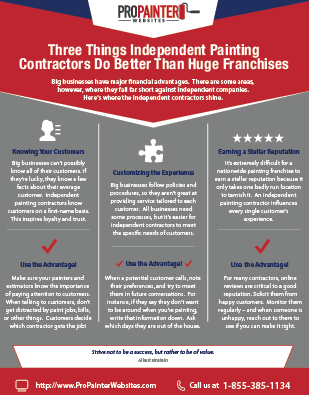Crucial Seasonal Aspects Of Commercial Exterior Painting: What You Must Comprehend
Crucial Seasonal Aspects Of Commercial Exterior Painting: What You Must Comprehend
Blog Article
Web Content Created By-Ford Skafte
When you're planning a commercial exterior painting task, seasonal elements can make or damage your outcomes. You'll intend to consider just how temperature level and humidity impact paint application and drying times. Picking the best season can guarantee your paint sticks effectively and lasts longer. However which inside painters are truly the most effective for this sort of job? Let's check out the key elements that can affect your job's success.
The Effect of Temperature on Paint Application
When you're preparing a commercial outside painting project, the temperature can considerably influence how well the paint sticks and dries.
Ideally, you want to repaint when temperature levels vary between 50 ° F and 85 ° F. If it's as well chilly, the paint may not cure correctly, causing concerns like peeling off or breaking.
On the flip side, if it's too warm, the paint can dry too swiftly, preventing correct attachment and leading to an uneven surface.
You ought to likewise take into consideration the time of day; morning or late afternoon uses cooler temperatures, which can be extra positive.
Always check the maker's referrals for the specific paint you're making use of, as they usually supply advice on the optimal temperature level variety for optimal outcomes.
Moisture and Its Result on Drying Times
Temperature level isn't the only environmental variable that affects your commercial outside paint project; moisture plays a considerable duty too. High moisture levels can slow down drying times considerably, affecting the overall top quality of your paint job.
When the air is filled with wetness, the paint takes longer to cure, which can lead to problems like bad attachment and a higher danger of mildew development. If you're repainting on a particularly moist day, be prepared for extensive delay times in between layers.
It's important to keep an eye on local weather and plan accordingly. Ideally, aim for humidity levels between 40% and 70% for optimum drying out.
Keeping https://residential-painters-near64310.ssnblog.com/34085239/using-the-solutions-of-a-specialist-paint-firm-can-bring-about-a-striking-change-in-your-house-s-interior-however-what-various-other-unusual-advantages-might-await-you consider mind ensures your project remains on track and delivers an enduring coating.
Best Seasons for Commercial Outside Paint Projects
What's the very best time of year for your industrial exterior paint tasks?
https://www.bankrate.com/homeownership/tips-for-house-painting-like-a-pro/ and early fall are commonly your best bets. Throughout these seasons, temperatures are moderate, and moisture levels are often lower, producing excellent problems for paint application and drying out.
Stay clear of summertime's intense heat, which can create paint to completely dry also quickly, resulting in inadequate bond and finish. Similarly, winter months's chilly temperature levels can prevent appropriate drying and treating, risking the durability of your paint task.
Go for days with temperatures in between 50 ° F and 85 ° F for ideal outcomes. Bear in mind to check the local weather prediction for rain, as wet problems can wreck your job.
Preparation around these aspects guarantees your painting job runs efficiently and lasts much longer.
Conclusion
In conclusion, intending your business outside paint projects around seasonal factors to consider can make a considerable distinction in the result. By scheduling work throughout the optimal temperatures and humidity levels, you'll make sure better bond and drying out times. Remember to keep an eye on regional weather report and choose the right time of year-- spring and very early autumn are your best choices. Taking these actions will certainly assist you achieve a durable and specialist surface that lasts.
